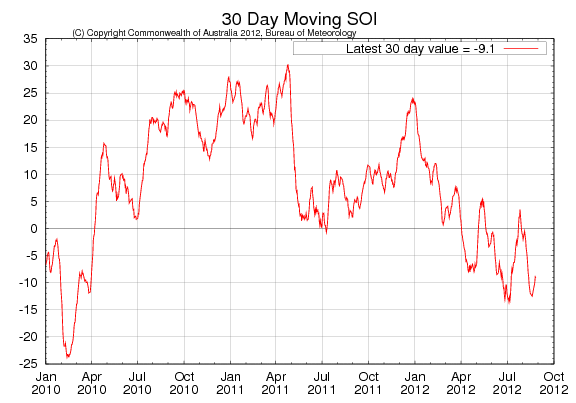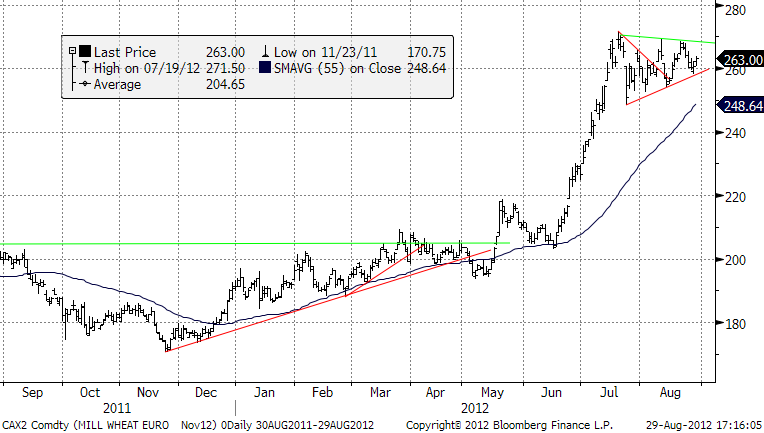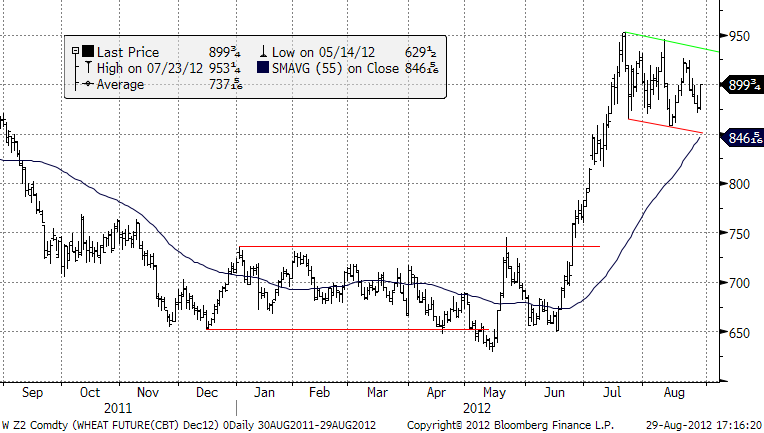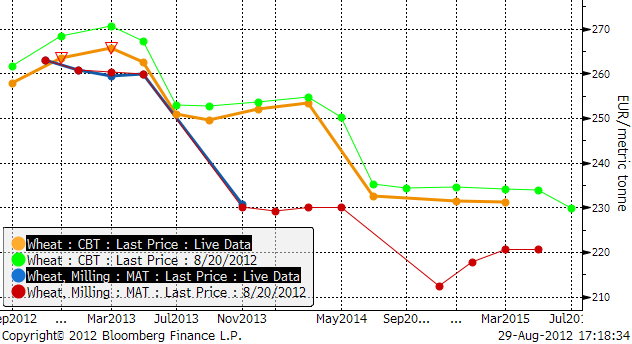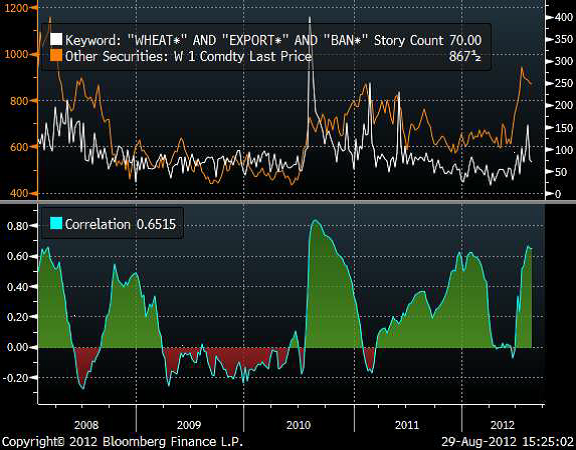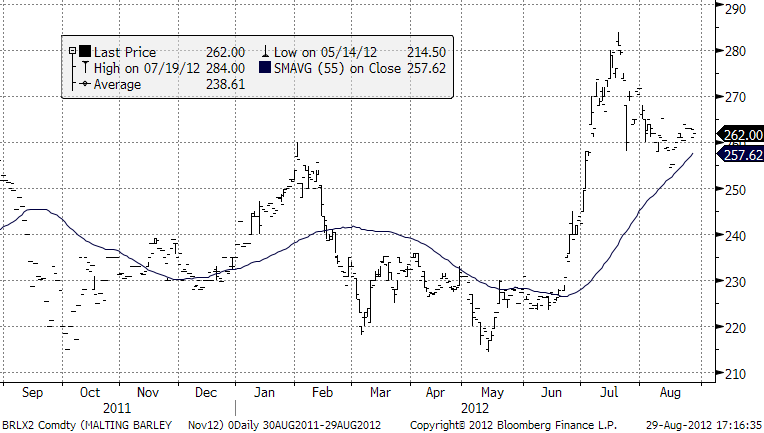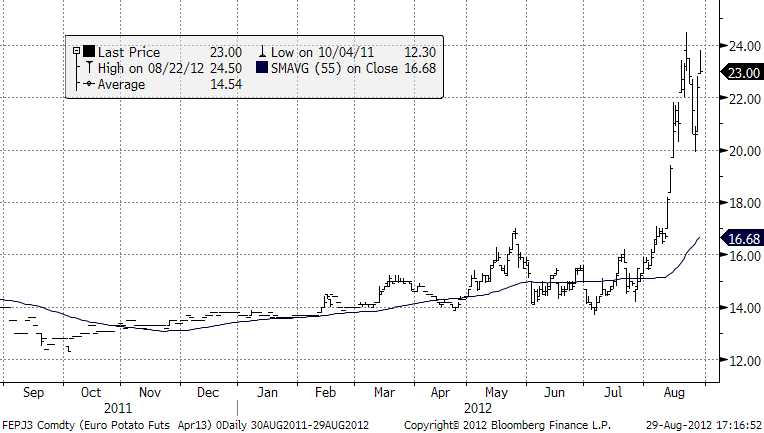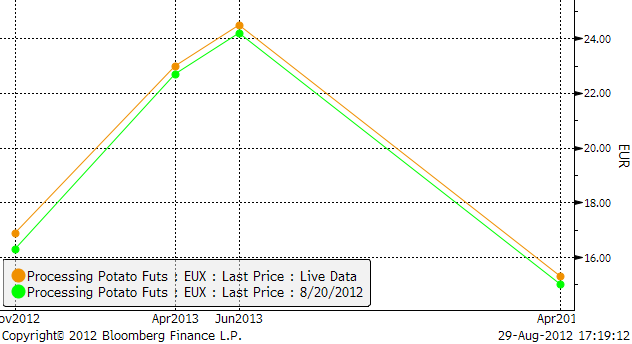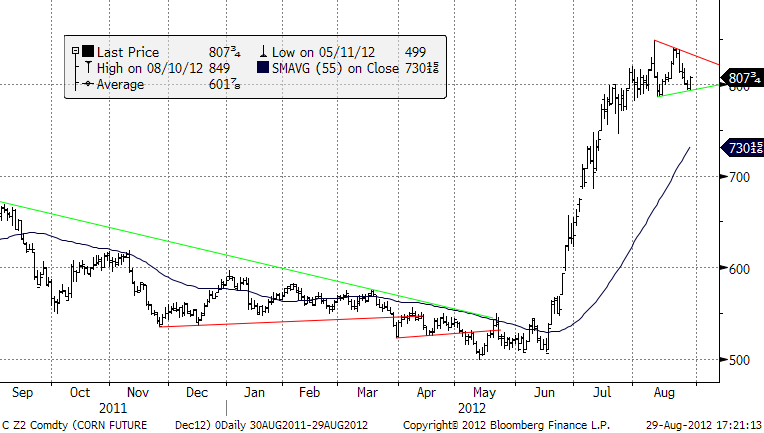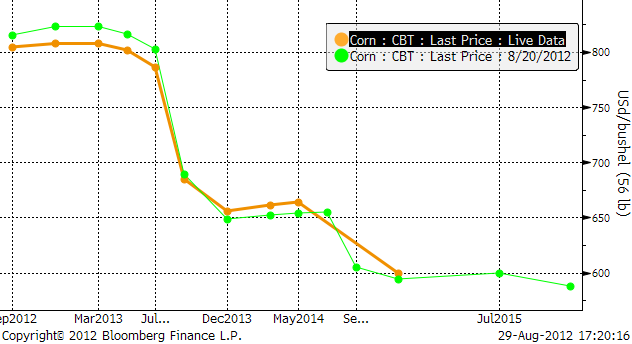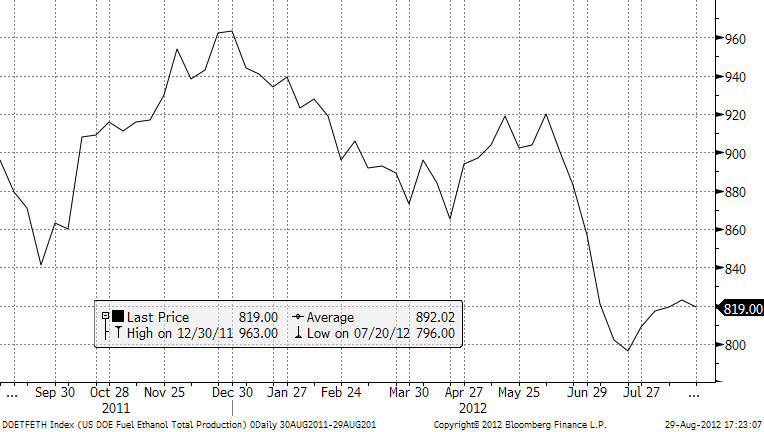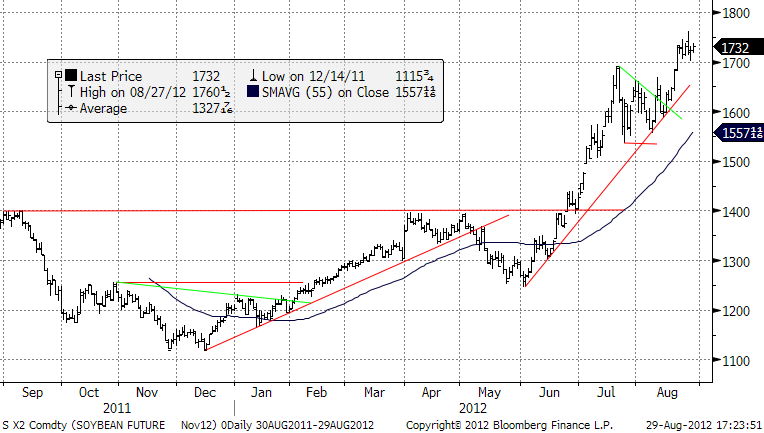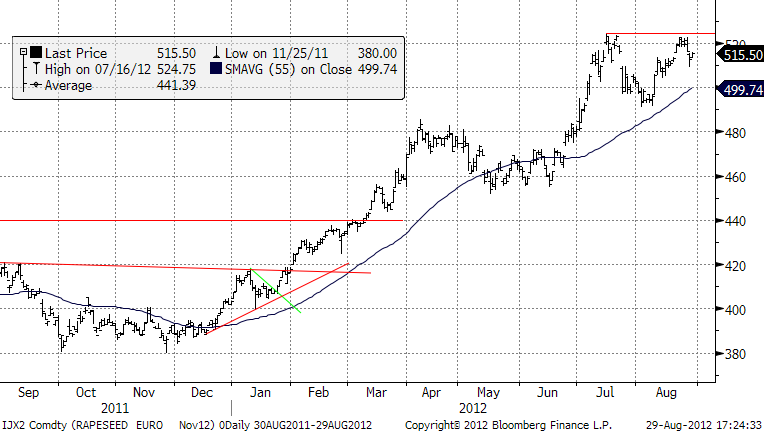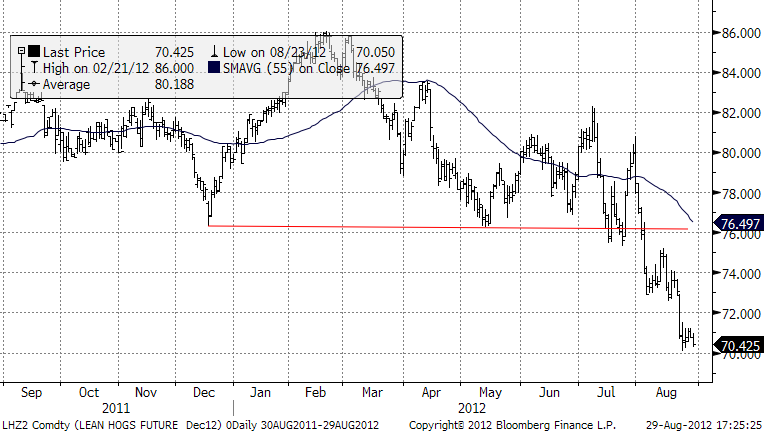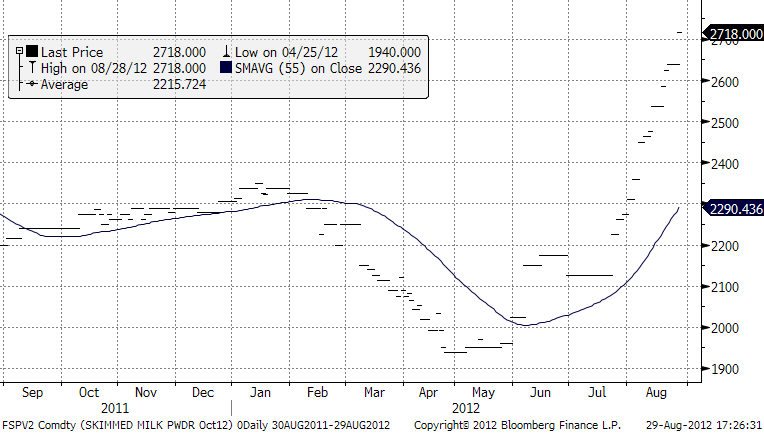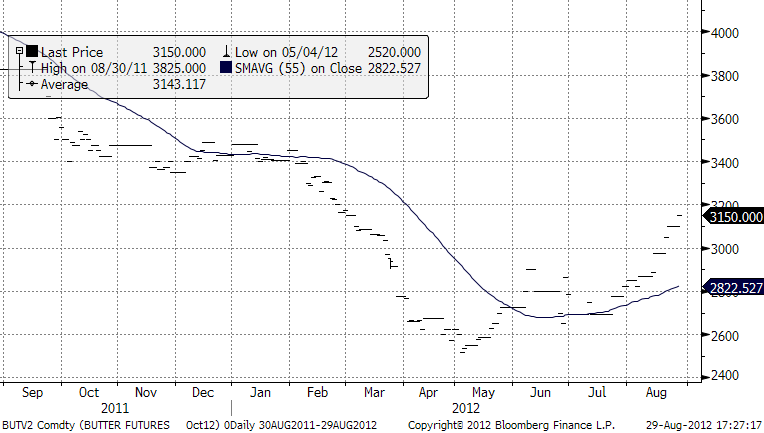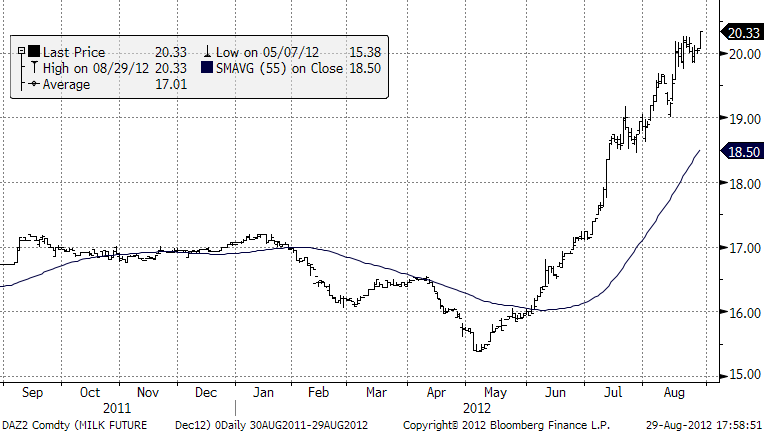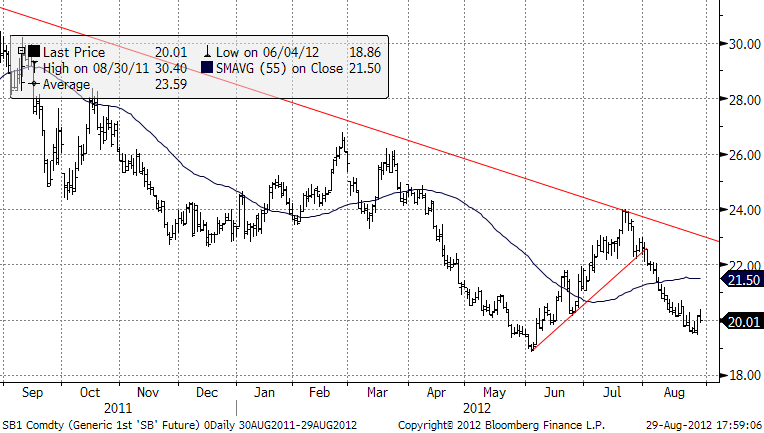Analys
SEB Jordbruksprodukter, 30 augusti 2012
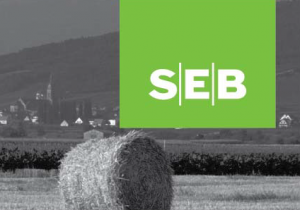 Det har varit stora prisuppgångar på spannmål i sommar. Det finns tecken på att majspriset faktiskt börjar ransonera efterfrågan på majs. Såväl vete som sojabönor ser fortfarande starka ut.
Det har varit stora prisuppgångar på spannmål i sommar. Det finns tecken på att majspriset faktiskt börjar ransonera efterfrågan på majs. Såväl vete som sojabönor ser fortfarande starka ut.
På fredag är det ministermöte (igen) i Ryssland om skörde- och exportsituationen. Nästa vecka kommer WASDE-rapporten. Det finns inte mycket nyheter för marknaden att ta fasta på innan dess, så det lär inte hända så mycket – om nu inte Ryssland ger oss någon nyhet.
Odlingsväder
ENSO fortsätter att surfa på gränsen till ett riktigt El Niño. SOI ligger under gränsen för El Niño på -8. Däremot har andra indikatorer som molnighet inte uppvisat typiska El Niñomönster de senaste två veckorna. Klimatmodeller prognosticerar att ENSO kommer att fortsätta ligga på gränsen fram till slutet av året eller in i början på 2013, för att sedan återgå till normala ENSO-förhållanden.
Vete
Tekniskt har Matif-november fortsatt att röra sig inom den triangel som vi anser kommer att brytas på uppsidan. Ett sådant brott uppåt har enligt den tekniska analysen potential att gå upp till 286 euro per ton. Det finns två potentiella triggers för detta. Det ryska ministermötet på fredag och WASDE-rapporten nästa vecka.
Nedan ser vi Chicagovetet med leverans i december. Den tekniska bilden indikerar samma sak här.
I diagrammet nedan ser vi terminspriserna framåt i tiden för Chicago och Matif och förändringen från 7 dagar sedan. Vi ser att backwardation har minskat i USA. Priset för leverans nästa november (2013) är ca 20 euro per ton högre i Chicago än i Paris.
Det ryska jordbruksministeriet rapporterade igår (onsdag) att 53.4 mt spannmål och baljväxter har skördats hittills. Avkastningen ligger på 1.92 mt / ha. Förra året var det 2.63 ton/ha. Det är en minskning med 27%. Jordbruksministern upprepade sin prognos om en skörd på 75 mt, en minskning med 20% från förra årets 94 mt. Han sade att exportpotentialen är 12 mt. 2011/12 exporterade Ryssland 21.6 mt, enligt USDA.
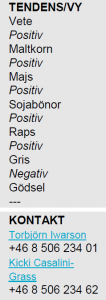 Nu på fredag möts ryska ministrar och experter och diskuterar skörden och exportmöjligheterna. Vi har tidigare visat att Rysslands nya medlemskap i WTO inte har tagit bort risken för ett exportstopp. Enligt WTO:s regelverk får Ryssland införa exportbegränsningar om det meddelar de andra länderna och om exportstoppet är tillfälligt, och det lär det ju vara.
Nu på fredag möts ryska ministrar och experter och diskuterar skörden och exportmöjligheterna. Vi har tidigare visat att Rysslands nya medlemskap i WTO inte har tagit bort risken för ett exportstopp. Enligt WTO:s regelverk får Ryssland införa exportbegränsningar om det meddelar de andra länderna och om exportstoppet är tillfälligt, och det lär det ju vara.
Det är naturligtvis svårt för oss på SEB att följa vad som sägs i hela världen om exportstopp i alla länder. Ett enkelt sätt är att räkna alla artiklar som innehåller nyckelorden Wheat+Export+Ban och det ser vi nedan. Den senaste veckan har det talats mindre om exportstopp. Kanske marknaden är trött på ”storyn”.
Det franska jordbruksministeriet meddelade igår att ”World Food Security Situation Not Threatened for Now”. Fast de sade det väl på franska. Frankrike har inrättat det så kallade ”Rapid Response Forum” förra året för att hindra att länder inför exportbegränsningar. Det är en del av ”The Agricultural Market Information System” som inrättats på beslut av G20. Jag förmodar att de får anledning att träffas igen snart, allra senast efter USDA:s rapport nästa vecka.
De två senaste veckorna har det kommit ner nederbörd över Indien, vilket har fått läget att ljusna för grödor som majs, ris och sojabönor. 50% av Indien är drabbat av torka. Det minskar trycket på staten att införa exportbegränsningar. Arealen sådd med ris har ökat till 32.9 miljoner hektar från 30.8 förra året. Förra årets skörd var rekordhöga 91.5 mt, enligt det indiska jordbruksministeriet.
Orkanen Isaac som nådde fastlandet via Louisiana ger nederbörd, som förbättrar markfukten inför höstsådden av SRWW, även om stormen också fördröjer fältarbetet.
Maltkorn
Novemberkontraktet på maltkorn har funnit stöd och ser ur teknisk synvinkel ut att kunna stiga den närmaste tiden.
Potatis
Potatishaussen fick priset att fortsätta stiga efter förra veckobrevet. Efter att ha nått över 24 euro per deciton, föll priset hastigt tillbaka till 20 euro, men har de senaste två dagarna åter stigit och ligger nu på 23 euro. Vi vet att det fanns säljare på över 24 euro, så det återstår att se om de är starka nog.
Nedan ser vi terminskurvan för industripotatis på Eurex. Priset för nästa års skörd ligger på 15 euro per deciton. Det är det man ska räkna med att få betalt för nästa års skörd.
Tycker man att det är en bra prisnivå kan man välja att sälja terminer för att prissäkra. Korrelationen över skördeåren mellan tysk industripotatistermin och till och med svensk matpotatisnotering är högre än 0.5. Prissäkring med de här terminerna ger en riskminskning. Trots att det är en annan kvalitet och ett annat land.
Majs
Majspriset har inte riktigt lyckats hitta nya toppnivåer och det är ett svaghetstecken. Marknaden ligger inom en triangelformation. Ett brott nedåt ur den vore inte bra och skulle innebära att vi skulle reducera långa positioner kraftigt och kanske till och med gå kort.
Nedan ser vi terminskurvan framåt i tiden för majs.
Måndagens crop ratings för majs var kom in med 22% i good/excellent condition. Förra veckan var det 23%. Poor / Very poor kom in på 52% (upp en procentenhet).
Orkanen Isaac, som nådde fastlandet vid Louisiana kommer att ge mellan 70 och 80 mm nederbörd över Missouri de kommande tre dagarna, enligt National Weather Service. Det kommer också att blåsa en hel del och det kan skada majsfälten som pga torkan har svaga stjälkar. Berörda stater är Louisiana, Alabama, Arkansas och Mississippi. Etanolproduktionen har nu äntligen minskat efter de senaste veckornas uppgång. Det är en minskning från 823,000 fat/dag till 819,000 fat, enligt DOE:s veckostatistik. Vi får tolka det som att det finns tecken på att det höga majspriset faktiskt ransonerar konsumtionen.
Enligt USDA-rapporten den 10 augusti går 42% av amerikansk majsproduktion till etanolproduktion. Priset på etanol har backat i pris de senaste dagarna.
Sojabönor
Triangelformationen är bruten på uppsidan och har nu etablerat sig över toppen från juli. Vi ser det som en konsolidering inför nästa uppgångsfas, till den teoretiska målkursen 1879 cent / bu.
Crop conditions visar en minskning på 1% i kategorin ”good” och en ökning i ”very poor”. 38% är i poor / very poor condition medan 30% är good eller very good condition. Orkanen Isaac ger nederbörd, som berört under majs-avsnittet, men nederbörden är för sen för att påverka sojaskörden, eftersom den är tre veckor tidig och sojabönornas baljor redan är satta.
Raps
Vi tror alltjämt att rapsterminen för novemberleverans är på väg högre. Den snabba ”dippen” häromdagen, som återhämtade sig så snabbt, tyder på att köparna fortfarande har kommandot över marknaden. På ovansidan finns ett motstånd på 524.75 euro per ton. Vi tror att det ska testas igen – och övervinnas.
Gris
Grispriset befinner sig i en tydlig bear market. Nedan ser vi baissen på grismarknaden.
Mjölk
Priset på mjölkpulver i Nordeuropa har fortsatt att stiga ännu en vecka. Nedanför ser vi oktoberkontraktet. Det har fortsatt att öka till 2718, från 2625 euro per ton.
Nedan ser vi priset på smör, också oktoberkontraktet såsom handlat på EUREX. Priset är angivet i euro per ton.
På den amerikanska börsen har priset också stigit. EUREX som representerar marknaden i Europa har börjat bli allt mer med världsmarknadens pris, representerat av terminerna i Chicago.
Socker
Priset på socker har studsat upp från strax under 20 cent och ligger nu på nästan exakt 20 cent. Trenden är ner, men trenden är också gammal.
EURSEK
EURSEK svarar på ett starkt tekniskt stöd. Vi tror på sidledes rörelse den närmaste veckan. Augustis sidledes rörelse såg först ut som en paus inför fortsatt nedgång, men man ska inte se kursrörelser som i tisdags och i onsdags i en korrektion. Vi kan nu få se en uppgång mot 8.50 kr per euro.
USDSEK
Dollarn har svarat på supportområdet och hoppat upp från det. Stödet ligger vid 6.60 kr. Priset kan i första hand gå upp till 6.80, men det mest troliga är fortsatt sidledes rörelse med stödet under.
[box]SEB Veckobrev Jordbruksprodukter är producerat av SEB Merchant Banking och publiceras i samarbete och med tillstånd på Råvarumarknaden.se[/box]
Disclaimer
The information in this document has been compiled by SEB Merchant Banking, a division within Skandinaviska Enskilda Banken AB (publ) (“SEB”).
Opinions contained in this report represent the bank’s present opinion only and are subject to change without notice. All information contained in this report has been compiled in good faith from sources believed to be reliable. However, no representation or warranty, expressed or implied, is made with respect to the completeness or accuracy of its contents and the information is not to be relied upon as authoritative. Anyone considering taking actions based upon the content of this document is urged to base his or her investment decisions upon such investigations as he or she deems necessary. This document is being provided as information only, and no specific actions are being solicited as a result of it; to the extent permitted by law, no liability whatsoever is accepted for any direct or consequential loss arising from use of this document or its contents.
About SEB
SEB is a public company incorporated in Stockholm, Sweden, with limited liability. It is a participant at major Nordic and other European Regulated Markets and Multilateral Trading Facilities (as well as some non-European equivalent markets) for trading in financial instruments, such as markets operated by NASDAQ OMX, NYSE Euronext, London Stock Exchange, Deutsche Börse, Swiss Exchanges, Turquoise and Chi-X. SEB is authorized and regulated by Finansinspektionen in Sweden; it is authorized and subject to limited regulation by the Financial Services Authority for the conduct of designated investment business in the UK, and is subject to the provisions of relevant regulators in all other jurisdictions where SEB conducts operations. SEB Merchant Banking. All rights reserved.
Analys
Brent crude ticks higher on tension, but market structure stays soft

Brent crude has climbed roughly USD 1.5-2 per barrel since Friday, yet falling USD 0.3 per barrel this mornig and currently trading near USD 67.25/bbl after yesterday’s climb. While the rally reflects short-term geopolitical tension, price action has been choppy, and crude remains locked in a broader range – caught between supply-side pressure and spot resilience.

Prices have been supported by renewed Ukrainian drone strikes targeting Russian infrastructure. Over the weekend, falling debris triggered a fire at the 20mtpa Kirishi refinery, following last week’s attack on the key Primorsk terminal.
Argus estimates that these attacks have halted ish 300 kbl/d of Russian refining capacity in August and September. While the market impact is limited for now, the action signals Kyiv’s growing willingness to disrupt oil flows – supporting a soft geopolitical floor under prices.
The political environment is shifting: the EU is reportedly considering sanctions on Indian and Chinese firms facilitating Russian crude flows, while the U.S. has so far held back – despite Bessent warning that any action from Washington depends on broader European participation. Senator Graham has also publicly criticized NATO members like Slovakia and Hungary for continuing Russian oil imports.
It’s worth noting that China and India remain the two largest buyers of Russian barrels since the invasion of Ukraine. While New Delhi has been hit with 50% secondary tariffs, Beijing has been spared so far.
Still, the broader supply/demand balance leans bearish. Futures markets reflect this: Brent’s prompt spread (gauge of near-term tightness) has narrowed to the current USD 0.42/bl, down from USD 0.96/bl two months ago, pointing to weakening backwardation.
This aligns with expectations for a record surplus in 2026, largely driven by the faster-than-anticipated return of OPEC+ barrels to market. OPEC+ is gathering in Vienna this week to begin revising member production capacity estimates – setting the stage for new output baselines from 2027. The group aims to agree on how to define “maximum sustainable capacity,” with a proposal expected by year-end.
While the IEA pegs OPEC+ capacity at 47.9 million barrels per day, actual output in August was only 42.4 million barrels per day. Disagreements over data and quota fairness (especially from Iraq and Nigeria) have already delayed this process. Angola even quit the group last year after being assigned a lower target than expected. It also remains unclear whether Russia and Iraq can regain earlier output levels due to infrastructure constraints.
Also, macro remains another key driver this week. A 25bp Fed rate cut is widely expected tomorrow (Wednesday), and commodities in general could benefit a potential cut.
Summing up: Brent crude continues to drift sideways, finding near-term support from geopolitics and refining strength. But with surplus building and market structure softening, the upside may remain capped.
Analys
Volatile but going nowhere. Brent crude circles USD 66 as market weighs surplus vs risk

Brent crude is essentially flat on the week, but after a volatile ride. Prices started Monday near USD 65.5/bl, climbed steadily to a mid-week high of USD 67.8/bl on Wednesday evening, before falling sharply – losing about USD 2/bl during Thursday’s session.

Brent is currently trading around USD 65.8/bl, right back where it began. The volatility reflects the market’s ongoing struggle to balance growing surplus risks against persistent geopolitical uncertainty and resilient refined product margins. Thursday’s slide snapped a three-day rally and came largely in response to a string of bearish signals, most notably from the IEA’s updated short-term outlook.
The IEA now projects record global oversupply in 2026, reinforcing concerns flagged earlier by the U.S. EIA, which already sees inventories building this quarter. The forecast comes just days after OPEC+ confirmed it will continue returning idle barrels to the market in October – albeit at a slower pace of +137,000 bl/d. While modest, the move underscores a steady push to reclaim market share and adds to supply-side pressure into year-end.
Thursday’s price drop also followed geopolitical incidences: Israeli airstrikes reportedly targeted Hamas leadership in Doha, while Russian drones crossed into Polish airspace – events that initially sent crude higher as traders covered short positions.
Yet, sentiment remains broadly cautious. Strong refining margins and low inventories at key pricing hubs like Europe continue to support the downside. Chinese stockpiling of discounted Russian barrels and tightness in refined product markets – especially diesel – are also lending support.
On the demand side, the IEA revised up its 2025 global demand growth forecast by 60,000 bl/d to 740,000 bl/d YoY, while leaving 2026 unchanged at 698,000 bl/d. Interestingly, the agency also signaled that its next long-term report could show global oil demand rising through 2050.
Meanwhile, OPEC offered a contrasting view in its latest Monthly Oil Market Report, maintaining expectations for a supply deficit both this year and next, even as its members raise output. The group kept its demand growth estimates for 2025 and 2026 unchanged at 1.29 million bl/d and 1.38 million bl/d, respectively.
We continue to watch whether the bearish supply outlook will outweigh geopolitical risk, and if Brent can continue to find support above USD 65/bl – a level increasingly seen as a soft floor for OPEC+ policy.
Analys
Waiting for the surplus while we worry about Israel and Qatar

Brent crude makes some gains as Israel’s attack on Hamas in Qatar rattles markets. Brent crude spiked to a high of USD 67.38/b yesterday as Israel made a strike on Hamas in Qatar. But it wasn’t able to hold on to that level and only closed up 0.6% in the end at USD 66.39/b. This morning it is starting on the up with a gain of 0.9% at USD 67/b. Still rattled by Israel’s attack on Hamas in Qatar yesterday. Brent is getting some help on the margin this morning with Asian equities higher and copper gaining half a percent. But the dark cloud of surplus ahead is nonetheless hanging over the market with Brent trading two dollar lower than last Tuesday.

Geopolitical risk premiums in oil rarely lasts long unless actual supply disruption kicks in. While Israel’s attack on Hamas in Qatar is shocking, the geopolitical risk lifting crude oil yesterday and this morning is unlikely to last very long as such geopolitical risk premiums usually do not last long unless real disruption kicks in.
US API data yesterday indicated a US crude and product stock build last week of 3.1 mb. The US API last evening released partial US oil inventory data indicating that US crude stocks rose 1.3 mb and middle distillates rose 1.5 mb while gasoline rose 0.3 mb. In total a bit more than 3 mb increase. US crude and product stocks usually rise around 1 mb per week this time of year. So US commercial crude and product stock rose 2 mb over the past week adjusted for the seasonal norm. Official and complete data are due today at 16:30.
A 2 mb/week seasonally adj. US stock build implies a 1 – 1.4 mb/d global surplus if it is persistent. Assume that if the global oil market is running a surplus then some 20% to 30% of that surplus ends up in US commercial inventories. A 2 mb seasonally adjusted inventory build equals 286 kb/d. Divide by 0.2 to 0.3 and we get an implied global surplus of 950 kb/d to 1430 kb/d. A 2 mb/week seasonally adjusted build in US oil inventories is close to noise unless it is a persistent pattern every week.
US IEA STEO oil report: Robust surplus ahead and Brent averaging USD 51/b in 2026. The US EIA yesterday released its monthly STEO oil report. It projected a large and persistent surplus ahead. It estimates a global surplus of 2.2 m/d from September to December this year. A 2.4 mb/d surplus in Q1-26 and an average surplus for 2026 of 1.6 mb/d resulting in an average Brent crude oil price of USD 51/b next year. And that includes an assumption where OPEC crude oil production only averages 27.8 mb/d in 2026 versus 27.0 mb/d in 2024 and 28.6 mb/d in August.
Brent will feel the bear-pressure once US/OECD stocks starts visible build. In the meanwhile the oil market sits waiting for this projected surplus to materialize in US and OECD inventories. Once they visibly starts to build on a consistent basis, then Brent crude will likely quickly lose altitude. And unless some unforeseen supply disruption kicks in, it is bound to happen.
US IEA STEO September report. In total not much different than it was in January
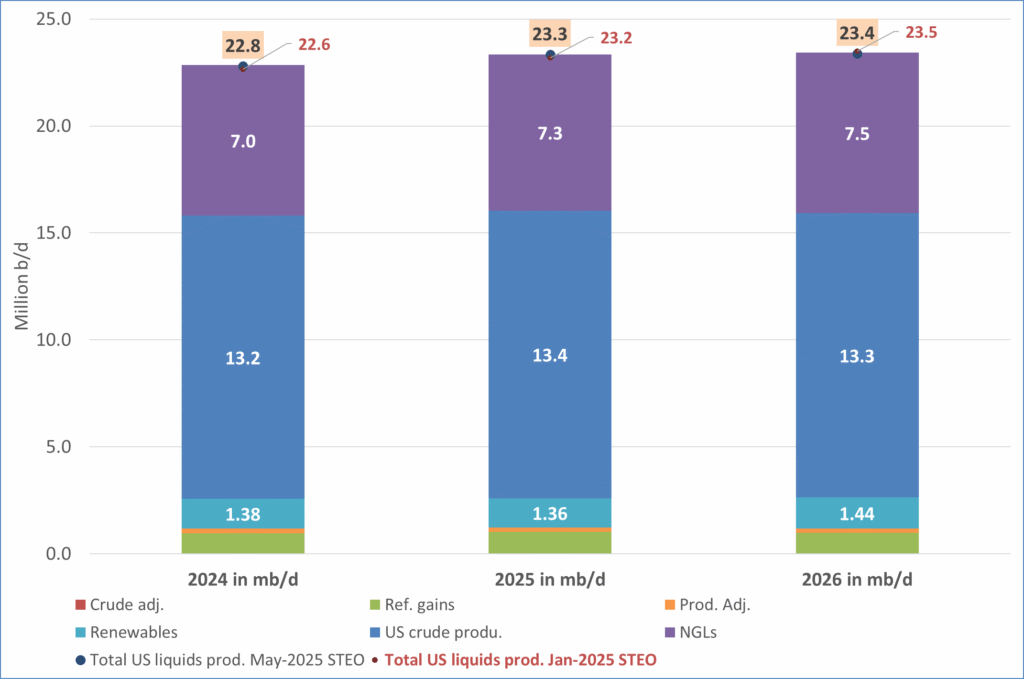
US IEA STEO September report. US crude oil production contracting in 2026, but NGLs still growing. Close to zero net liquids growth in total.

-

 Nyheter4 veckor sedan
Nyheter4 veckor sedanMeta bygger ett AI-datacenter på 5 GW och 2,25 GW gaskraftverk
-
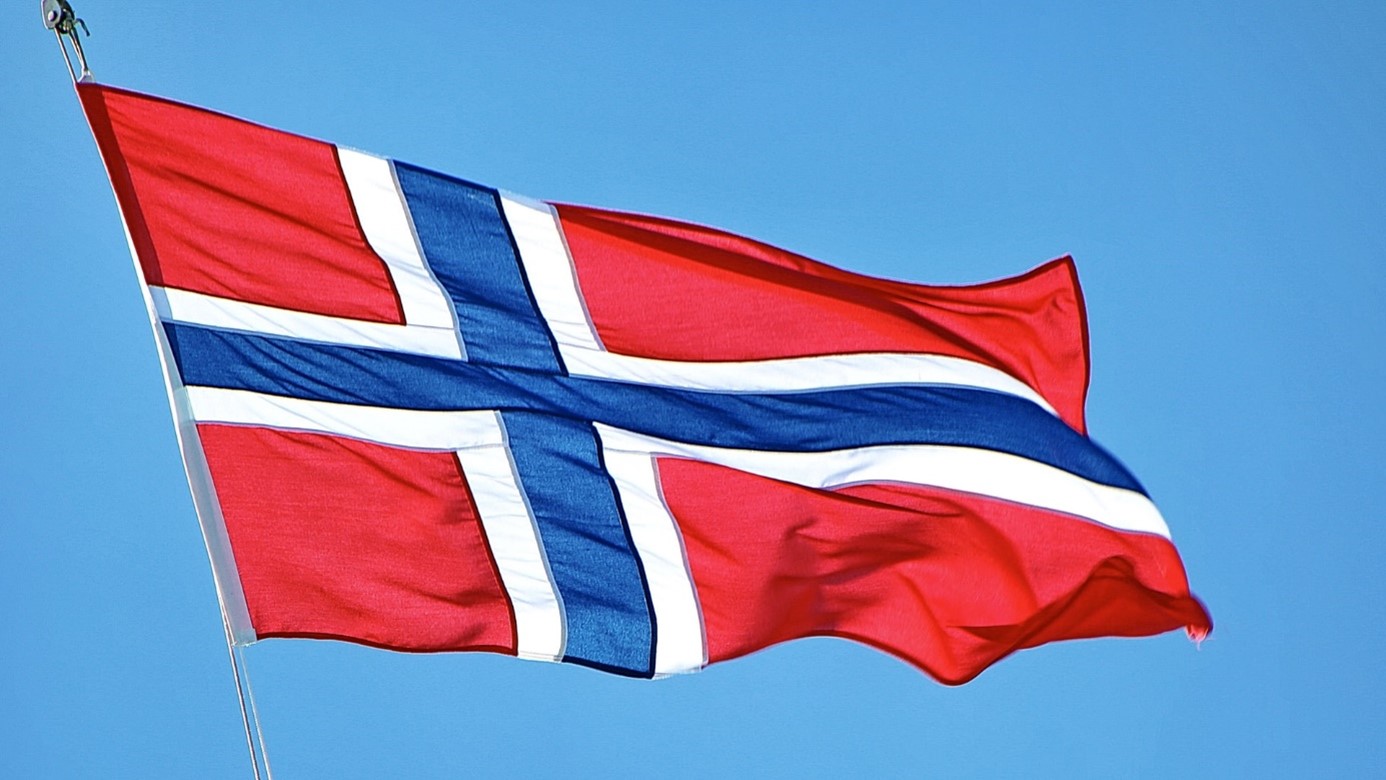
 Nyheter4 veckor sedan
Nyheter4 veckor sedanAker BP gör ett av Norges största oljefynd på ett decennium, stärker resurserna i Yggdrasilområdet
-

 Nyheter4 veckor sedan
Nyheter4 veckor sedanEtt samtal om koppar, kaffe och spannmål
-

 Analys4 veckor sedan
Analys4 veckor sedanBrent sideways on sanctions and peace talks
-

 Nyheter4 veckor sedan
Nyheter4 veckor sedanSommarens torka kan ge högre elpriser i höst
-

 Analys4 veckor sedan
Analys4 veckor sedanBrent edges higher as India–Russia oil trade draws U.S. ire and Powell takes the stage at Jackson Hole
-

 Nyheter3 veckor sedan
Nyheter3 veckor sedanMahvie Minerals är verksamt i guldrikt område i Finland
-

 Analys3 veckor sedan
Analys3 veckor sedanIncreasing risk that OPEC+ will unwind the last 1.65 mb/d of cuts when they meet on 7 September


